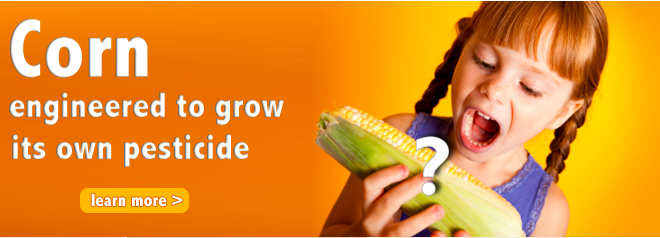This November, Californians will vote on an initiative that would require any food containing ingredients derived from genetically modified crops to be labeled as such.
Backers of the “California Right To Know Genetically Engineered Food Act” are pitching it as a matter of providing information to consumers, who, they argue, “have a right to know what’s in the food we buy and eat and feed our children, just as we have the right to know how many calories are in our food, or whether food comes from other countries like Mexico or China.”
I have no concerns about the safety of GMOs. But I support the right of people to make choices about what they eat, and think we should provide them with the information they need to do so.
I understand where some of the nervousness about GMOs comes from. I worry about the uncontrolled chemical experiments our species is doing on our bodies, and am a big consumer of organic foods. I am also skeptical when industries assert that their products are safe, because so often these claims have turned out to be false.
But I also appreciate the challenges of feeding our growing population, and believe in the power of biotechnology to not just make agriculture more efficient, but to make it better for people and the planet. And as a molecular biologist very familiar with the technology of genetic modification and the research into its safety, I do not find it in the least bit frightening.
What I do find frightening, however, is the way backers of this initiative have turned a campaign for consumer choice into a crusade against GMOs. They don’t want the “genetically engineered” label to merely provide information. They want it to be a warning – the equivalent for GM food of the cancer warning on cigarette boxes.
The problem is there is no justification for a warning. There is no compelling evidence of any harm arising from eating GMOs, and a diverse and convincing body of research demonstrating that GMOs are safe. But rather than reckon with this reality, anti-GMO campaigners have joined their climate-change denying brethren, and launched an agressive war on science.
Opponents of GMOs are so sure that GMOs are dangerous that any study suggesting they are safe must have been funded by Monsanto, and any scientist pointing out the holes in their arguments must be an industry shill. In the anti-GMO universe, it often seems that the best evidence that something must be true is the existence of multiple experiments showing it is false.
The language of the initiative itself contains clear misstatements of scientific consensus. For example, one of the “Findings and Declarations” states:
Government scientists have stated that the artificial insertion of DNA into plants, a technique unique to genetic engineering, can cause a variety of significant problems with plant foods. Such genetic engineering can increase the levels of known toxicants in foods and introduce new toxicants and health concerns.
While I’m sure they have a reference that justifies their making this assertion, the reality is that the US and EU government scientists have repeatedly and consistently demonstrated that GMOs are safe. For the backers of the initiative to claim otherwise as a finding of fact is an outright lie, and an outlandish attack on science.
If this initiative passes it will reify the war on science, and deal another body blow to the idea, already reeling from the climate change debate, that public policy should be based on good data and solid reasoning. It MUST be stopped.
The question of course is how. I am so infuriated with rhetoric from backers of the labeling campaign that I’m tempted to just sit here ridiculing the egregious misinformation, bad science, pseudoscience and non-science that they traffic in. This would make me less angry. But it wouldn’t be productive.
I suspect the most zealous opponents of GMOs are not open to being convinced. But, polls show, the bulk of the electorate doesn’t know a lot about this issue and probably come into the debate inclined both the support labeling and have vague fears about GMOs. So I am going to suppress my fury and be constructive and address these fears with the only tool at my disposal – science.
Following her article in the NYT on the labeling debate, Amy Harmon posted a series of “GMO FAQs” on Twitter, distilled from the ~500 comments posted following her story. These seem to capture a good chunk of the fears people have about genetic modification and GMO foods. And so, over the next several days, I am going to answer each of those questions, as well as a few of my own. Check back here (I’ll add the answers below as I get to them), or follow me on Twitter. And please participate in the discussion, and feel free to pose any more questions!
GMO FAQ (v2.0)
Question 1) Isn’t transferring genes from one species to another unnatural and intrinsically dangerous
The most striking thing about the GMO debate is the extent to which it contrasts “unnatural” GMOs against “natural” traditional agriculture, and the way that anti-GMO campaigners equate “natural” with “safe and good”. I’ll deal with these in turn.
The problem with the unnatural/natural contrast is not that it’s a mischaracterization of GMOs – they are unnatural in the strict sense of not occurring in Nature – rather that it is a frighteningly naive view of traditional agriculture.
Far from being natural, the transformation of wild plants and animals into the foods we eat today is – by far – the single most dramatic experiment in genetic engineering the human species has undertaken. Few of the species we eat today look anything like their wild counterparts, the result of thousands of years of largely willful selective breeding to optimize these organisms for agriculture and human consumption. And, in the past few years, as we have begun to characterize the genetic makeup of crops and farm animals, we are getting a clear picture of the extent to which traditional agricultural practices have transformed their DNA.
Let’s take a few examples. This is a Mexican grass known as teosinte and its seed.

Thousands of years of selection transformed this relatively nondescript plant into one of the mainstays of modern agriculture – corn. The picture below – which shows the seeds of teosinte on the left, and an ear of modern corn on the right – gives a pretty good sense of the scope of change involved in the domestication and improvement for agriculture of teosinte.

Thanks to the pioneering work of geneticist John Doebley, and more recently an international consortium who have sequenced the genome of maize and characterized genetic variation in teosinte and maize, we now have a good picture of just what happened to the DNA of teosinte to accomplish the changes in the structure of the plant and its seed: a recent paper that characterized the DNA of 75 teosinte and maize lines identified hundreds of variants that appear to have been selected during the process of domestication. And maize is not weird in this regard – virtually all agriculturally important plants have a similar story of transformation from wild ancestors as generations of farmers adapted them to be easier to grow, safer to eat, more nutritious, resistant to pests and other stresses, and tastier.
For most of history this crop domestication and improvement has been a largely blind process, with breeders selecting crossing individuals with desired traits and selecting the offspring who have inherited them until they breed true – unaware of the molecular changes underlying these traits and other changes to the plants that may have accompanied them.
Modern genetics has fundamentally altered this reality. It has increased the power breeders have to select for desirable traits using traditional methods, and makes it far easier ensure that undesirable have not come along for the ride. And it also gives us the ability to engineer these changes directly by transferring just the DNA that confers a trait from one individual in a species to another. There are many ways to accomplish this – the most common involves extracting the DNA you want to transfer from the donor, placing it into a bacterium whose natural life-cycle involves inserting its DNA into that of its host, and then infecting the target individual with this bacterium. But recently developed technologies make it possible to effectively edit the genome in a computer and then make the desired changes in the living organism.
When applied to transfer genetic information from one individual in a species to another, this is an intrinsically conservative form of crop improvement around since is all but eliminates the random genetic events that accompany even the most controlled breeding experiment.
The only difference between this and the generation of GMOs is that the transfered DNA comes not from a member of the same species, but from somewhere else on the tree of life. I understand why some people see this is a big difference, but modern molecular biology has shown us that all living things share a remarkably similar molecular toolkit, with the distinct properties of each species coming more from how these pieces are wired together than which ones are where.
Transferring a gene from a fish into a plant does not make the plant swim any more than stealing the radio from someone’s Maserati and putting it into my Honda Civic would turn it into a high-performance sports car. Indeed, scientists routinely use genes from mice, fungi, plants and even bacteria to substitute for their human counterparts, and vice-versa – which they often do perfectly.
And this doesn’t just happen in the lab. There are countless examples of genes moving naturally between species. Microorganisms swap DNA all the time – this is how antibiotic resistance spreads so quickly between species. Our own genome contains genes that got their start in bacteria and were subsequently taken up by one of our ancestors.
The relatively low rate of such “horizontal gene transfer” in multicellular organisms like plants and animals compared to bacteria is more a reflection of reproductive barriers and the defenses they have evolved to prevent viruses from hitchhiking in their DNA, than from a fundamental molecular incompatibility between species.
This is why I do not find the process of making GMOs unnatural or dangerous – certainly no more so than traditional breeding. And why I find the obsession with, and fearmongering about, GMOs to be so bizarre and irrational.
Of course the fact that making GMOs is not inherently dangerous does not mean that every GMO is automatically safe. I can think of dozens of ways that inserting a single gene into, say, soybeans could make them lethal to eat. But it would be because of what was inserted into them, not how it was done.
For what its worth, it would also be relatively easy to make crops plant dangerous to eat by strictly non-GM techniques. Essentially all plants make molecules that help them fight off insects and other pests. In the foods we eat regularly, these molecules are present at sufficiently low levels that they no longer constitute a threat to humans eating them. But it is likely that the production of these molecules could be ramped up when crossing crop varieties with wild stocks, or by introducing new mutations, and selecting for toxicity, much as one would do for any other trait. Indeed, there have been reports of potatoes that produce toxic levels of solanines and celery that produce unhealthy amounts of psoralens, both chemicals present at low levels in the crops. Which segways nicely into the next topic.
Last week I wrote about the anti-science campaign being waged by opponents of the use of genetically modified organisms in agriculture. In that post, I promised to address a series of questions/fears about GMOs that seem to underly peoples’ objections to the technology. I’m not going to try to make this a comprehensive reference site about GMOs and the literature on their use and safety. I’m compiling some general resources here, and a list of all FAQs here.
Question 2) Maybe GMOs aren’t automatically bad, but isn’t it obvious that it’s dangerous to consume crops that produce their own pesticides and can tolerate high doses of herbicides?
Approximately 90% of soybeans, maize, cotton and sugar beets grown in the US are have been genetically modified to produce a protein that kills common insect pests or to make them highly tolerant of an herbicide used to control weeds, or in some cases both. To make a rational judgment about whether these specific GMOs are good or bad, it’s important to understand exactly what they are and how they work.
Bt soy and corn
The pesticide resistant plants have been engineered to produce a protein isolated from the bacterium Bacillus thuringiensis (known generally Bt). Each strain of Bt produces a different version of the protein, known as Cry, each highly specific to a limited number of related species. Bt has evolved these proteins as a key part of a reproductive strategy in which they kill insects that ingest them and then eat nutrients released by the dying host. The Cry protein found in Bt spores must be activated by a protein-cleaving enzyme found in the host gut and then bind to a specific protein on the surface of cells in the digestive system, which Cry then destroys. Insects, who are not huge fans of this strategy, eventually evolve resistance by modifying one or both of these proteins. Bt stains that rely on this insect adapt in turn, creating highly-specific strain-insect relationships.
The irony of Cry becoming a major bugaboo of the anti-GMO movement is that, until the gene that produces it was inserted into corn, it was the poster-child of a “natural” insecticide, preferred over chemical pesticides because of the potential for extreme host specificity and complete biodegradability. Bt spores were sprayed on crops for decades, and are still widely used to control pests by organic farmers. But the effectiveness of Bt as an insecticide is limited because it degrades in the matter of days – more rapidly when it rains. This led agricultural biotechnology companies to try and insert Cry genes directly into the plants, and there are now many varieties on the market, each targeting pests that are a particular problem for a given crop (some varieties of Bt corn, for example, targets the European corn borer).
Given what we know about Cry proteins, there is very little reason to be concerned about the safety of eating it. These are proteins that have evolved to kill insects – and not just insects in general, but very specific subsets of insects. And humans are not insects. Regulatory agencies in the US and Europe have consistently rejected claims that plants that produce their own Cry cause problems in either humans or farm animals.
Nonetheless, anti-GMO activists continually raise the spectre of “plants that make their own pesticide” as if this alone was sufficient reason to not only avoid them, but to ban them. Here is a banner running on the website of one of the organizations pushing the CA GMO-labeling initiative:

If you don’t know a lot about plants, I can see how this would seem threatening. But this picture and the anti-GMO campaign it accompanies are based on the flawed premise that “normal” plants are pesticide free. This could not be farther from the truth. Almost since they first appeared on Earth, plants have had to reckon with a diverse array of animals determined to eat them. And this is a battle that continues today, as anyone who has tried to garden, or wandered through a forest, can attest. To fight off these pests, plants have evolved a dizzying array of defense mechanisms, including the production of a diverse arsenal of chemicals targeted at the insects and other pests that afflict them.
As far as I know, natural pesticides have been found in every plant in which they have been sought, including all conventionally grown crops. Wheat makes a family of proteins lethal to hessian flies, peas contain the insecticidal protein PA1b, tomatoes tomatine, and so on. And even if the corn in that picture was not genetically modified, that cute little girl is about to get a mouthful of the insecticide maysin. Indeed almost any mouthful of unprocessed plants from any source will likely contain some kind of natural pesticide that is inert in humans. There is nothing at all unusual, or particularly worrisome, about eating plants that contain the Bt Cry protein as we’ve been eating insecticides for eons.
I’m sure some people will say that we may have been eating insecticides all along, but we haven’t been eating Bt Cry protein and, under the “you never know” principle, should just avoid it. This would all be fine and good if there weren’t strong evidence supporting the value of Bt corn and soy in reducing pesticide use on farms and limiting collateral damage to insects that are in the vicinity of, but not eating, the relevant crop. As a panel of the US National Academies of Science reported in a 2010 study of GMOs:
The evidence shows that the planting of GE crops has largely resulted in less adverse or equivalent effects on the farm environment compared with the conventional non-GE systems that GE crops replaced. A key improvement has been the change to pesticide regimens that apply less pesticide or that use pesticides with lower toxicity to the environment but that have more consistent efficacy than conventional pesticide regimens used on non-GE versions of the crops.
To me, the demonization of Bt in anti-GMO rhetoric is a emblematic of everything that is wrong with the GMO debates. The producers of Bt crops have done a horrible job of explaining why plants expressing a single insecticidal protein should not – and do not – harm humans. And the anti-GMO advocates either have not bothered to understand the science behind their activity, or (worse) are cynically exploiting peoples’ fears of pesticides to promote their cause.
Glyphosate tolerant crops
The second major class of GMOs (mostly soy) have been engineered to be tolerant of the herbicide glyphosate (Roundup). Glyphosate is a small molecule that inhibits an enzyme, 5-enolpyruvylshikimate-3-phosphate synthase (EPSPS), which catalyzes an essential step in the biosynthesis of the amino acids phenylalanine, tyrosine and tryptophan. By denying rapidly growing plants these amino acids, it is able to rapidly inhibit grown of plants onto which it has been sprayed. Glyphosate is generally considered to be inert in humans, who get these amino acids from their food, and do not have an EPSPS.
The obvious problem with using glyphosate to control weeds is that it will, under normal circumstances, also kill crop plants. However, plants that have been engineered to express an alternative form of EPSPS that functions normally even in the presence of glyphosate. These plants are thus “Roundup Ready“, and will survive doses of glyphosate used to kill weeds in the field.
Although the EPSPS gene used in Roundup Ready plants comes from a bacterium, the necessary changes could now easily be made to the plant’s own copy of EPSPS. Thus Roundup Ready crops, which produce no new proteins not found prior to genetic manipulation, shouldn’t really be places in the same class of GMOs as Bt expressing plants, which are expressing a new protein. And there is absolutely no reason to expect that there are any health risks associated with eating the altered form of EPSPS found in glyphosate resistant transgenic plants.
Concern about Roundup Ready plants focuses instead on the adverse effect of glyphosate on people and the environment. There are some suggestions that high doses of glyphosate are bad for humans, though these studies are hotly contested (note this was a Monsanto-funded study and must be assessed with that in mind). But the more important question is whether the use of glyphosate in conjunction with Roundup Ready crops is better for humans and the environment than the alternatives. Here, the aforementioned NRC report concluded that:
GE soybeans, corn, and cotton are designed to be resistant to the herbicide glyphosate, which has fewer adverse environmental effects compared with most other herbicides used to control weeds.
This does not argue that glyphosate is safe. However, it suggests that the net effect of the GMO – Roundup Ready- has been positive. There is a bigger discussion to be had about the role of herbicides in farming – but this is really orthogonal to issues of genetic modification.
3) Why should I believe GM food is safe? Why should I trust the big companies that develop these crops? Didn’t it take years to realize PCBs, DDT, ‘good’ cholesterol, etc. were bad for us?
4) What about studies that show GM foods cause allergies, destroy organs and make mice sterile?
5) Why won’t GM crops will escape and contaminate non-GMO crops (and maybe the planet)
6) GM crops initially reduced spraying. But now we have resistant weeds&insects. Aren’t we on a ‘pesticide treadmill’?
7) Don’t GMOs destroy biodiversity?
8) Don’t GMOs undermine local agriculture in the developing world?
9) Aren’t Monsanto’s business practices enough to want to boycott GMOs?
About me
I am a molecular biologist with a background in infectious diseases, cancer genomics, developmental biology, classical genetics, evolution and ecology. I am not a plant biologist, but I understand the underlying technology and relevant areas of biology. I would put myself firmly in the “pro GMO” camp, but I have absolutely nothing material to gain from this position. My lab is supported by the Howard Hughes Medical Institute, the National Institutes of Health and the National Science Foundation. I am not currently, have never been in the past, and do not plan in the future, to receive any personal or laboratory support from any company that makes or otherwise has a vested interest in GMOs. My vested interest here is science, and what I write here, I write to defend it.




 I'm a biologist at UC Berkeley and an Investigator of the Howard Hughes Medical Institute. I work primarily on flies, and my research encompases evolution, development, genetics, genomics, chemical ecology and behavior. I am a strong proponent of open science, and a co-founder of the
I'm a biologist at UC Berkeley and an Investigator of the Howard Hughes Medical Institute. I work primarily on flies, and my research encompases evolution, development, genetics, genomics, chemical ecology and behavior. I am a strong proponent of open science, and a co-founder of the 